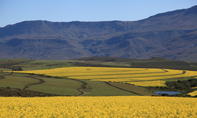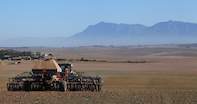Before a farmer can start crop farming in South Africa, they need to look at the resources available - water, land, funds and labour. This will affect the type of crop, time of planting, and size of planting.

The farmer also needs to decide what the crop will be used for - to prevent soil erosion, improve soil health, as a feed for livestock, as human food, for export or local use or as a cash crop? Of course, parameters such as climate type, accessibility to markets, equipment and demand will also influence crop farming and decisions about it.
Resources for a Crop Farming Business

Water
Determining which crop to plant will depend on what is already available. Is there water for irrigation, irrigation equipment, a borehole or natural water such as regular rainfall? What is the water quality, how consistent is the water supply and will the crop be adaptable to the water source?
Land and Soil
What size of land is available? Is it accessible for labour or machinery and what is the soil type?
A soil test to determine the soil type, nutrient content of the soil and general fertility and suitability for crop farming is essential. Consider dividing the land into smaller plots and fencing it to allow for rotation grazing, limit theft and access by neighbours’ animals and humans.
Funds
What funds are available to plant a crop? How capital intensive will a crop be and how much time will elapse before a harvest can be marketed. For example, compare the costs to establish an olive orchard which will take a few years to show a profit compared to the cost of establishing a hectare of different vegetables, which can be harvested throughout the year. A strong business plan is essential to access funds such as a loan or grant.
Labour
Will crop farming on your farm demand manual labour or is machinery available? If staff is available, will the crop farming overlap with other aspects of farming? Is machinery available or can machinery be rented? If so, determine fuel costs, wages and specific skills such as drivers needed for your specific crop.
Which Crop to Plant?
Deciding on which crops to plant can be complex and the advice of a seed supplier or agricultural economist can be valuable.
Climate vs Crop
Your farm’s climate, soil type and rainfall will determine the success of the crop. For example, sorghum and millet are drought-resistant crops suitable for human and animal feed, while humid climates will favour banana and sugar cane production.
End-use of Crops
Ideally, a crop will improve the soil, provide food for animals and humans as well as provide an income. In South African crops may also be planted in between permanent crops such as fruit trees, to stabilise soil on slopes and to improve water penetration into the soil.
Legumes such as cowpeas increase the nitrogen in the soil. It is an excellent cover crop, provides grazing or hay for animals and can be harvested for its protein-rich leaves and seeds to be eaten by humans. Similarly, sorghum is equally a drought-tolerant crop that increases organic matter in the soil and can be grazed by animals and harvested for its grains, to make hay or for bio-ethanol production.
Price of Crops
A report ‘outlook of agricultural production, consumption, prices and trade in South Africa for 2018 to 2027’ by the Bureau for Food and Agricultural Policy (BFAP) has predicted trends for crops in South Africa.
Recent plantings of field crops in South Africa reflect significant changes in crop planting. It has shown that crops such as yellow maize (mainly as an animal feed) and soybeans are expanding, mostly at the expense of white maize, which is primarily a food staple. This is due to both lower profits for grain producers as well as the demand for animal feed grains as farmers are restocking their herds after recent droughts.
Input Costs of Producing Crops
The Bureau for Food and Agricultural Policy (BFAP) also predicts that between 2018 to 2027 rising oil prices and a depreciating exchange rate of the South African rand in relation to other currencies will increase farming input costs of fertiliser and fuel. So efficient use of both resources can reduce costs.
Incorporating legumes in pasture mixes or cash crops might assist with building nitrogen reserves in the soil and can reduce nitrogen-fertilisation costs. Similarly, using crop residues to compost and applying mulches can build moisture holding capacity in the soil and reduce irrigation costs.
By Marinda Louw